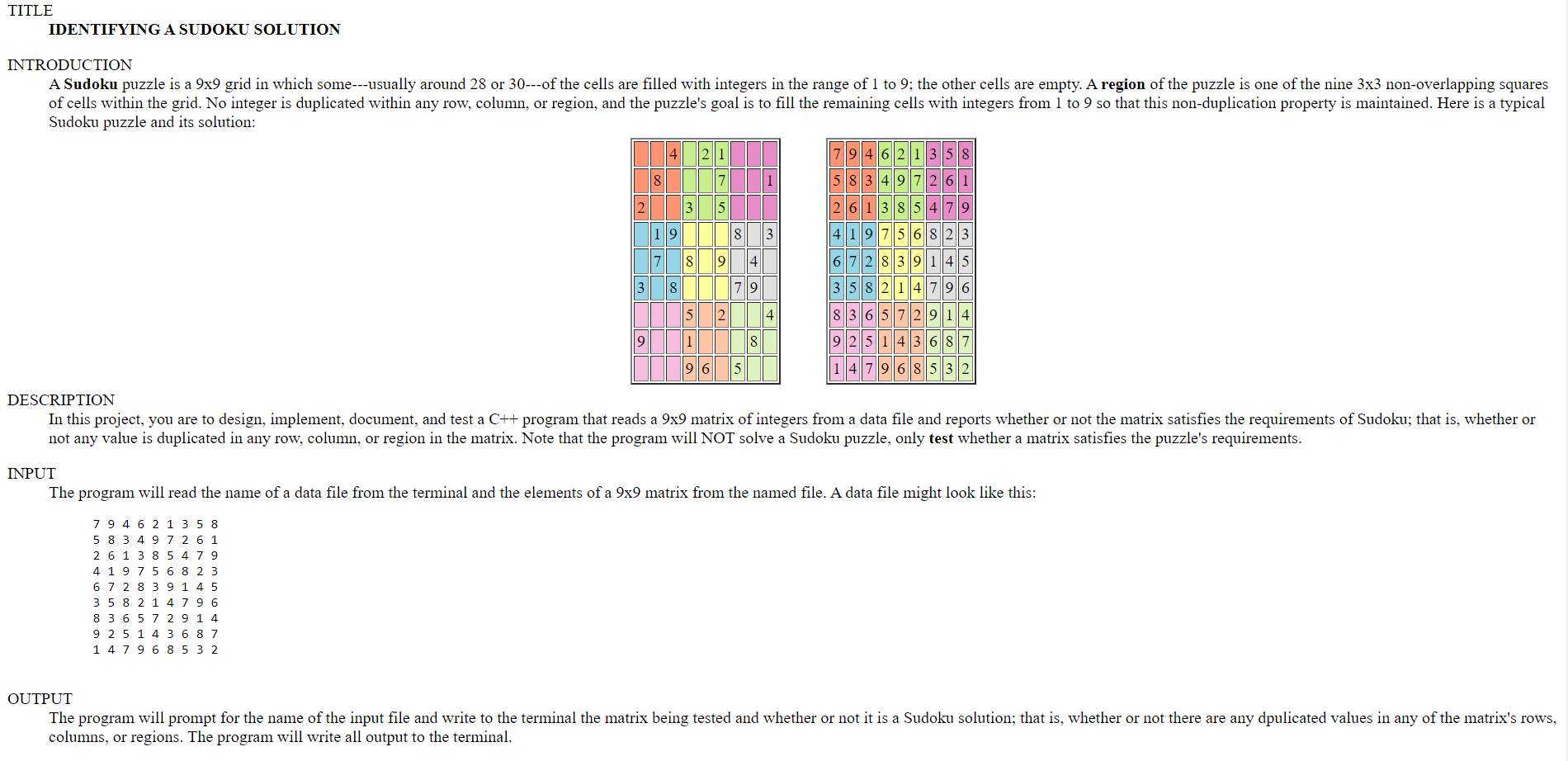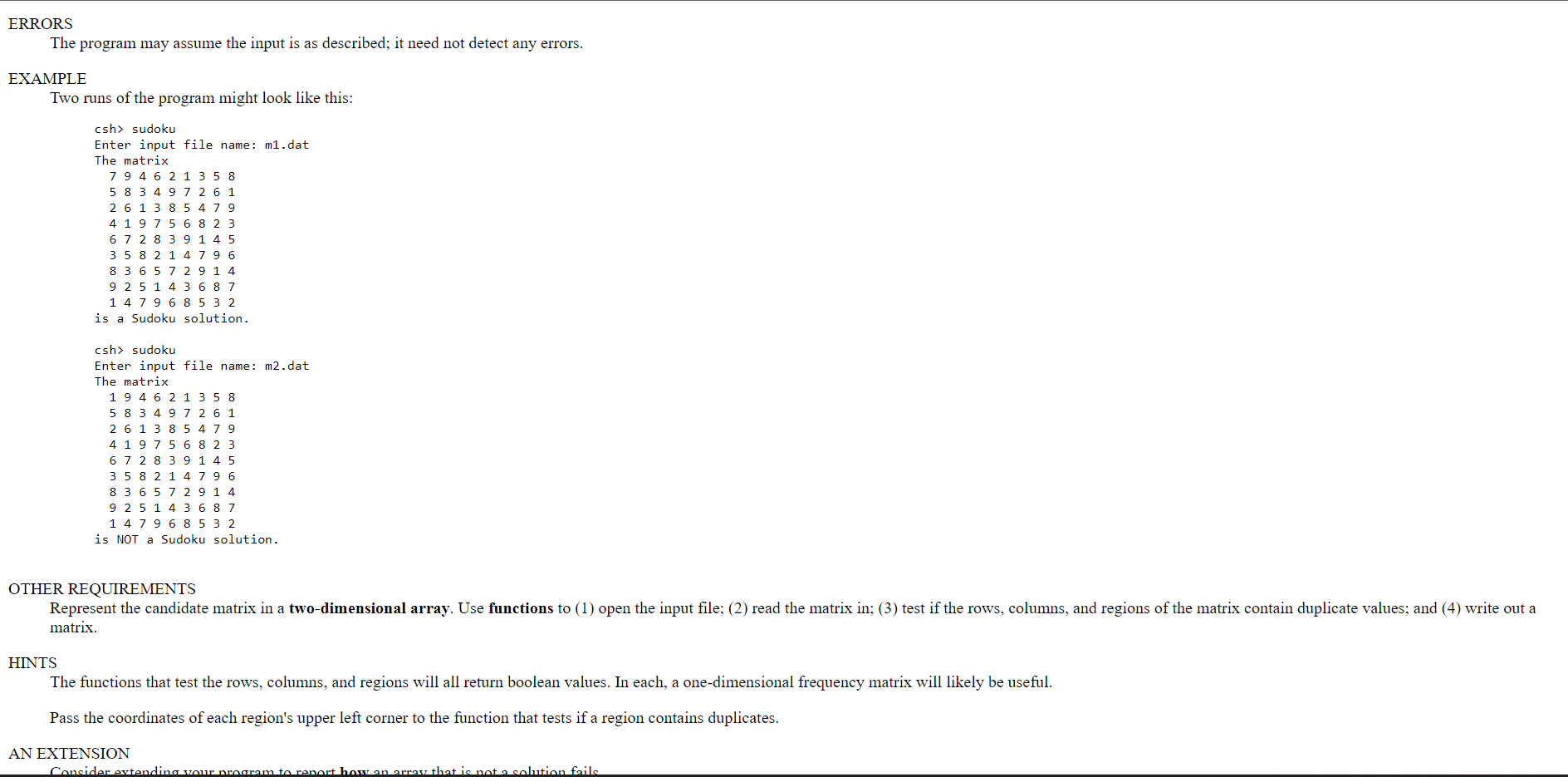In c++ without using # include 

TITLE IDENTIFYING A SUDOKU SOLUTION INTRODUCTION A Sudoku puzzle is a 9x9 grid in which some---usually around 28 or 30---of the cells are filled with integers in the range of 1 to 9; the other cells are empty. A region of the puzzle is one of the nine 3x3 non-overlapping squares of cells within the grid. No integer is duplicated within any row, column, or region, and the puzzle's goal is to fill the remaining cells with integers from 1 to 9 so that this non-duplication property is maintained. Here is a typical Sudoku puzzle and its solution: 4 21 LP 94621358 8 5 834 97261 2 3 2613181514719 il 9 8 3 4|19 5168123 8 9 4 6 39145 3 ao RAHA 719 3 719 6 4 9 8 43687 916 7|96|85|312 DESCRIPTION In this project, you are to design, implement, document, and test a C++ program that reads a 9x9 matrix of integers from a data file and reports whether or not the matrix satisfies the requirements of Sudoku; that is, whether or not any value is duplicated in any row, column, or region in the matrix. Note that the program will NOT solve a Sudoku puzzle, only test whether a matrix satisfies the puzzle's requirements. INPUT The program will read the name of a data file from the terminal and the elements of a 9x9 matrix from the named file. A data file might look like this: 7 9 4 6 2 1 3 5 8 5 8 3 4 9 7 2 6 1 261 38 5 4 7 9 4 1 9 7 5 6 8 23 6728 3 9 1 4 5 3 5 8 2 1 4 7 9 6 8 36 572 9 1 4 9 2 5 1 4 3 6 8 7 1 479 68 5 3 2 OUTPUT The program will prompt for the name of the input file and write to the terminal the matrix being tested and whether or not it is a Sudoku solution; that is, whether or not there are any dpulicated values in any of the matrix's rows, columns, or regions. The program will write all output to the terminal. ERRORS The program may assume the input is as described; it need not detect any errors. EXAMPLE Two runs of the program might look like this: csh> sudoku Enter input file name: m1.dat The matrix 7 9 4 6 2 1 3 5 8 58 34 9 7 26 1 261 3 8 5 4 7 9 41 975 68 2 3 6 7 2 8 3 9 1 4 5 35 8 2 1 4 796 8 3 6 5 7 2 9 1 4 9 2 5 1 4 3 687 1 4 7 9 6 8 5 3 2 is a Sudoku solution. csh> sudoku Enter input file name: m2.dat The matrix 1 9 4 6 2 1 3 5 8 5 8 3 4 9 7 2 6 1 26 13 8 5 4 7 9 4 1 975 68 23 67 2 8 3 9 1 4 5 35 8 2 1 4 7 96 8 3 6 5 7 2 9 1 4 9 2 5 1 4 3 687 1 4 7 9 6 8 5 3 2 is NOT a Sudoku solution. OTHER REQUIREMENTS Represent the candidate matrix in a two-dimensional array. Use functions to (1) open the input file; (2) read the matrix in; (3) test if the rows, columns, and regions of the matrix contain duplicate values; and (4) write out a matrix. HINTS The functions that test the rows, columns, and regions will all return boolean values. In each, a one-dimensional frequency matrix will likely be useful. Pass the coordinates of each region's upper left corner to the function that tests if a region contains duplicates. AN EXTENSION Consider extending your program to renart how an array that is not a solution fails








